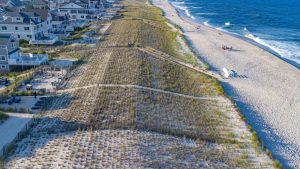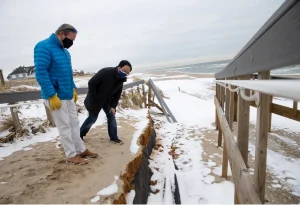“Perpetual” Storm Protection???

Circa 2018 project picture.
Long-time owners of ocean-front property in New Jersey and Long Island engaged in a ritual every Spring or early Summer. Pushing sand that had eroded from winter storms. It was almost a right of passage. That all changed after Hurricane Sandy when government intervened with the all too familiar, “we’re here to help.”
In New Jersey, the Army Corps of Engineers and the New Jersey Dep’t of Environmental Protection implemented a “dune project” from the Manasquan Inlet to the Barnegat Inlet. At the time, much of the beachfront property was privately owned. And as noted above, the private property owners maintained their private property by pushing sand that had eroded from winter storms. Between 2015 and 2017, the NJDEP commenced hundreds of condemnation cases to seize perpetual “Storm Damage Reduction Easements” that converted exclusive private property to non-exclusive land subject to the dominant rights of the State.
The State’s rights included the right to fill the private property with sand to erect a 22 foot high dune and berm system that was designed to provide a measure of storm protection. The State also took the right to maintain the beach and dune system. At that point in time, it became illegal for the private property owner to maintain their own property. To be clear, the private property owners could no longer engage in their annual collective sand pushes to ameliorate winter storm erosion.
The property owners’ complaints fell on deaf ears in the legislature and judiciary. One of the main complaints, in addition to loss of the right to exclude, was the loss of the right to maintain their property. The government retort was — we will maintain the property “perpetually”. This, despite the fact the project was not funded “perpetually.”
Now, 11 years after Sandy, and about 5 years after the government took over the beach maintenance, the New York Times Metropolitan section reports, “Hard Work Washed Away With a Single Winter Storm.” (Sunday August 13, 2023). “Just a few years ago, the beach at Fire Island Pines was almost as wide as a football field, the result of a $1.7 billion government project to combat erosion on the South Shore of Long Island after Hurricane Sandy…. But efforts to protect Fire Island, and the legacy of the government anti-erosion project, appear hamstrung by rules that make the U.S. Army Corps of Engineers responsible for maintenance and emergency repairs on any beach they have built, a stark change from the more flexible approach that local leaders said was possible before Sandy…. Now we’re at the mercy of the Army Corps. There’s no beach out there.”
The residents of Fire Island join the chorus of other oceanfront communities who no longer organize and quickly implement emergency beach repairs.
In response to the winter erosion pictured above in Mantoloking, the Army Corps declined to help New Jersey, because “the Corps does not believe that the damage caused by the nor’easter would qualify as “an extraordinary event,” the designation the Corps must meet before it can place sand on badly damaged beaches before scheduled “renourishment” projects.” More information about this saga was the subject of an interview ith MROD’s Anthony DellaPelle on the Infrastructure Junkies Podcast ealier this year: Son of a Beach: Property Rights in the Cross Hairs of Storm Mitigation Efforts!
On Fire Island, the alarm bells are ringing because they “may now be in the most vulnerable state we have ever been in.”
If the State and federal government fails to perform as promised when it was granted the right to take private property by eminent domain, perhaps the easement should be extinguished by the Court. Why not?








